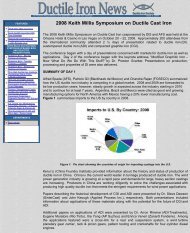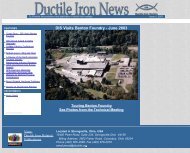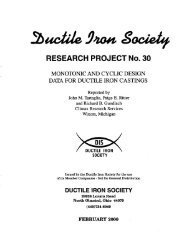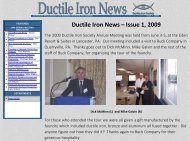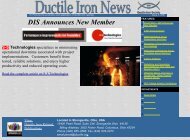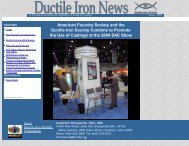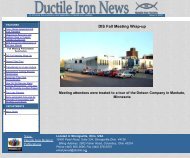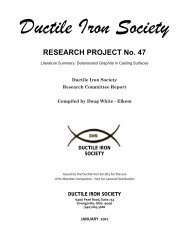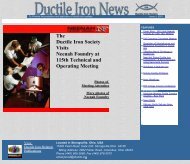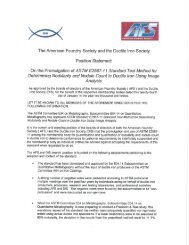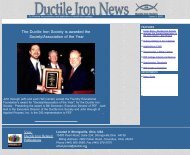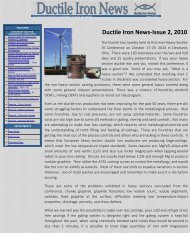Issue No. 1, 2003 - Ductile Iron Society
Issue No. 1, 2003 - Ductile Iron Society
Issue No. 1, 2003 - Ductile Iron Society
Create successful ePaper yourself
Turn your PDF publications into a flip-book with our unique Google optimized e-Paper software.
To Promote the production and application of ductile iron castings <strong>Issue</strong> 1, <strong>2003</strong><br />
FEATURES<br />
Cover Story - Associations Join to<br />
• Promote Castings to Transportation<br />
Industries<br />
Auditing Sand Profiles for a Quality<br />
• Green Sand System<br />
Intermet Introduces New Ferrous<br />
• Material at <strong>2003</strong> SAE World<br />
Congress<br />
• Eliminating Carbides in <strong>Ductile</strong> <strong>Iron</strong><br />
Improving Melting Yield through<br />
• Better Furnace Operation<br />
DEPARTMENTS<br />
• News Briefs<br />
• Advertisers<br />
• Back <strong>Issue</strong>s<br />
• DIS Home Page<br />
Details<br />
of this event<br />
View<br />
<strong>Ductile</strong> <strong>Iron</strong> Related<br />
Publications<br />
Located in Strongsville, Ohio, USA<br />
15400 Pearl Road, Suite 234; Strongsville,Ohio 44136<br />
Billing Address: 2802 Fisher Road, Columbus, Ohio 43204<br />
Phone (440) 665-3686; Fax (440) 878-0070<br />
email:jwood@ductile.org
To Promote the production and application of ductile iron castings <strong>Issue</strong> 1, <strong>2003</strong><br />
FEATURES<br />
Cover Story - Associations Join to<br />
• Promote Castings to Transportation<br />
Industries<br />
Auditing Sand Profiles for a Quality<br />
• Green Sand System<br />
Intermet Introduces New Ferrous<br />
• Material at <strong>2003</strong> SAE World<br />
Congress<br />
• Eliminating Carbides in <strong>Ductile</strong> <strong>Iron</strong><br />
Improving Melting Yield through<br />
• Better Furnace Operation<br />
DEPARTMENTS<br />
Associations<br />
• News Briefs<br />
• Advertisers<br />
• Back <strong>Issue</strong>s<br />
• DIS Home Page<br />
Join to Promote Castings to<br />
Transportation Industries<br />
The AFS Marketing Division, Diecasting Development Council<br />
(DDC) and <strong>Ductile</strong> <strong>Iron</strong><br />
Marketing Group (DIMG) joined<br />
together for a "Metalcasting:<br />
Giving Form to Innovation"<br />
exhibit at the <strong>2003</strong> <strong>Society</strong> of<br />
Automotive Engineers (SAE)<br />
World Congress & Expo in<br />
March. The 400-sq-ft exhibit<br />
featured a display of awardwinning<br />
transportation castings as well as the distribution of<br />
Engineered Casting Solutions magazines and other materials for<br />
engineers and purchasers. The AFS Technical Dept. also<br />
coordinated a 23-paper metalcasting track as part of the SAE<br />
Congress.<br />
Pictured from left are Gene Muratore, DIMG; Mike Lessiter, AFS;<br />
and Leo Baran, DDC.<br />
View<br />
<strong>Ductile</strong> <strong>Iron</strong> Related<br />
Publications<br />
Located in Strongsville, Ohio, USA<br />
15400 Pearl Road, Suite 234; Strongsville,Ohio 44136<br />
Billing Address: 2802 Fisher Road, Columbus, Ohio 43204<br />
Phone (440) 665-3686; Fax (440) 878-0070<br />
email:jwood@ductile.org
To Promote the production and application of ductile iron castings <strong>Issue</strong> 1, <strong>2003</strong><br />
FEATURES<br />
Cover Story - Associations Join to<br />
• Promote Castings to Transportation<br />
Industries<br />
Auditing Sand Profiles for a Quality<br />
• Green Sand System<br />
Intermet Introduces New Ferrous<br />
• Material at <strong>2003</strong> SAE World<br />
Congress<br />
• Eliminating Carbides in <strong>Ductile</strong> <strong>Iron</strong><br />
Improving Melting Yield through<br />
• Better Furnace Operation<br />
DEPARTMENTS<br />
Auditing<br />
• News Briefs<br />
• Advertisers<br />
• Back <strong>Issue</strong>s<br />
• DIS Home Page<br />
Sand Profiles<br />
for a Quality Green Sand System<br />
(Developing a Database)<br />
by George DiSylvestro<br />
DiSylvestro Videography Service<br />
Abstract<br />
The successful progress in casting metals with silica sand as its<br />
basic mold or core molding material, has been continuous and<br />
profitable. This has made surviving metal casting plants improve in<br />
quality production and growth. Achieving these goals, has been<br />
gratifying for those who have committed themselves to a<br />
continuous search and implementation of excellence.<br />
Production research and dissemination of information regarding the<br />
control of a green sand molding system, has been in separate<br />
reports of various areas of the casting process.<br />
Listed here, are the most important testing, control and<br />
standardization issues for those who wish to evaluate, compare,<br />
improve, or profile their entire existing sand system. This can be<br />
used to identify problem areas causing poor production, increased<br />
costs and barriers for needed quality improvements.<br />
Auditing and Control<br />
The control and auditing of a green sand system has been on a<br />
continuous improvement incline. Progressive foundries confirm the<br />
need for correct information from sources that influence quality and<br />
ultimately can reduce casting losses.<br />
Using a molding sand form such as per Form #1 confirmed that<br />
many foundries have limited auditing and testing, until a serious<br />
problem occurs. Then they immediately grope for answers and<br />
sometimes find they have no standards for reference, when quality<br />
castings had been produced previously.<br />
By using a daily reporting form similar to Form #2, developed and<br />
acted on by experienced production personnel, process<br />
abnormalities can be revealed quickly. This information should be<br />
reviewed by all who attend daily scrap meetings for analysis of<br />
previous casting cycles. This will encourage immediate action to be<br />
taken when necessary.<br />
A step further in the search for excellence, would be to combine<br />
metallurgy and pouring information with data gained from Forms<br />
#1 and #2. Having a similar surveillance form for metal production<br />
to synergize with sand reporting could put all of the valuable<br />
current operating information in the hands of the decision makers.<br />
Define the Existing System<br />
To develop a data bank, we use the foundation of current accurate<br />
information that characterizes the molding sand. A research study<br />
can be very rewarding to deter abnormalities that occur of
consequence.<br />
To understand and pinpoint the critical auditing areas for<br />
maintenance and engineering, an up-to-date sketch of the entire<br />
sand system (including dust collection) should be made available as<br />
is. Unfortunately many times changes or improvements, in<br />
equipment, processing or transporting, are made and never<br />
reported. This has been known to cause major problems, including<br />
safety and environmental mishaps.<br />
An article published in the <strong>Ductile</strong> <strong>Iron</strong> News, <strong>Issue</strong> #3, 1998, on<br />
"Prioritizing of Green Sand Testing," reveals a complete<br />
description of primary and secondary tests that can be performed.<br />
Reviewing this article is a prerequisite for the following<br />
information to standardize and document casting quality when it is<br />
at the optimum level, to achieve your goals for excellence.<br />
Profile the Sand System<br />
The following listing of tests, auditing areas, and procedures are<br />
suggested as raw material evaluation, material specifications and<br />
certification, mulling and molding equipment performance.<br />
Raw material evaluation<br />
Material specification and certification<br />
Mulling and molding equipment performance<br />
Mulling cycle and consistency<br />
Compacting characteristics during molding<br />
Effectiveness, efficiency and control of dust collectors<br />
This review does not coerce the quality control department to run<br />
all of these tests and auditing documentation. To know your sand<br />
systems limitations, it is suggested consideration to complete a one<br />
time testing with accurate documentation of critical areas.<br />
Especially at a time of acceptable level of production, quality and<br />
low scrap. Be certain of the accuracy and establish ranges of<br />
acceptance or tolerance.<br />
Distribute and educate all departments and inspectors so that they<br />
have complete knowledge of what these test values are and how<br />
they may affect operating conditions, especially, when safety is<br />
compromised. When a significant change from normal occurs, it<br />
becomes urgent to re-audit and make a complete routine<br />
comparison of any one of these six profiles.<br />
Recommended Profiles<br />
The profiles are listed in order of their priority and can be used as a<br />
bench mark for introducing a new material or making a major<br />
change.<br />
1. Base sand and system sand quality.<br />
2. Evaluation & characteristics of bentonite<br />
3. Evaluation & characteristics of sea coal, carbons and<br />
additives.<br />
4. Mulling, mixing & effect of water<br />
5. Molding sand compaction tests<br />
6. Dust collector and controls<br />
Molding Sand Quality Profiles<br />
1. Grain size distribution and base sand quality of system sand.<br />
A. Suppliers certificate of analysis as shipped
B. Unwashed and washed sand sieve analysis<br />
C. Percentage of sand balls, clay balls, core butts and<br />
waterproofing test<br />
D. "The silica program" sand autopsy.<br />
E. Autopsy of fines from dust collector system<br />
See Reference #1<br />
Base Sand Quality<br />
Since approximately 90% of the mold is sand, a major effort should<br />
be given to this profile for your database. The standardization and<br />
testing of sand is fairly simple. The effects of minor changes can be<br />
very influential and affect most all other sand characteristics.<br />
Changes can be gradual and not detected easily. Look for changes<br />
in casting finish, bond and water requirements, permeability and<br />
sand compaction. Cost differences for a quality sand that fits the<br />
casting needs, are mostly due to plant geography. The sand fineness<br />
and size frequency with uniform compaction, is basic and<br />
determines the casting finish and casting dimensions.<br />
Evaluation of the bentonite Bond<br />
List specifications of bentonite(s) used, trade name,<br />
description, chemical and physical analyses<br />
Bond activation time and durability tests, air set, dry, hot and<br />
baked retained strengths can be obtained from supplier or<br />
performed internally.<br />
Viscosity and gel profiles of bentonites in water separately and in<br />
composition of the premixture with water at different solids<br />
content.<br />
See Reference #2<br />
Dialogue on Bonding Requirements<br />
The profile for bentonite clay, the second main constituent in<br />
molding clay, has much influence on the molding characteristics<br />
and determines the thermal properties at casting temperatures. The<br />
casting weight or mold weight as poured, pattern configuration or<br />
design, usually determines the type of bentonite or blend required.<br />
The combination of sodium and calcium bentonites can assist<br />
greatly in producing consistent shakeout if the water content is<br />
controlled. This is a must to prevent the loss of sand from lumps in<br />
the sand system and to keep the hoppers full as much as possible.<br />
There can be a great influence on mulling energy and time needed<br />
when blending clays. Sodium bentonite requires the most. For these<br />
reasons, confirming the clay bond and its consistency is very<br />
important in achieving and maintaining best production and casting<br />
dimensions.<br />
Evaluation of Carbons and Additives<br />
Suppliers specifications of carbon or cellulose additives<br />
Test and record volatile content and loss on ignition<br />
Ash content of sea coal at 1850oF for 1 hour<br />
Approximate production of lustrous carbon oxidizing or<br />
reducing atmosphere of additives<br />
Develop calculations for control of an adequate reducing<br />
atmosphere.<br />
See Reference #3 and #4
Application of Seacoal Carbons & Additives<br />
The removal of sand from the casting is a great expense in the<br />
casting production cycle. The function of carbons such as seacoal,<br />
gilsonite or seacoal replacements, play a major role in developing<br />
the degree of casting peel, shakeout and casting defects. The<br />
distinguishing features in these profiles can produce very favorable<br />
economics of operation, especially when they affect the foundry<br />
atmosphere and environment. Most cast irons require a consistent<br />
carbonaceous volatile at casting temperatures to overcome the<br />
oxidizing effect of steam, which results from sand moisture. This<br />
control can reduce and prevent burn-on, burn-in, and chemical<br />
penetration on the surface of the casting.<br />
See Reference #5<br />
Mulling tests and the Effect of Water<br />
Bond vs. temper water, bond development during mulling to<br />
evaluate bentonite clay or pre-mixtures. Degree of mulling<br />
required<br />
Friability and moldability tests<br />
Mulling cycle profile and standardization of moldability<br />
controller (maintenance)<br />
Aerator settings and condition of sand at molding station<br />
(sand balls)<br />
System sand temperature profile from shakeout, through<br />
muller and a point of use<br />
Standardization of water used and use of black water for<br />
environmental reasons.<br />
See Reference #6<br />
Dialogue on Mixing and Mulling<br />
The Muller or mixing equipment is a key factor for producing sand<br />
consistency to approach homogeneity with the returned sand,<br />
bonding clay, additives and water. The compactability of the<br />
molding sand distinguishes the uniformity achieved in the mold and<br />
compliments the molding process and molding machine. The<br />
amount of water required is determined by the sand, bentonite and<br />
additive profiles. Mulling performance can be monitored<br />
automatically, if other profiles are held as constant as possible. The<br />
returning sand temperature is the most difficult to control and is<br />
influenced greatly by the sand to metal ration, cooling equipment<br />
(if any) and the storage inventory and transportation method. The<br />
quality and temperature of the water used can change the molding<br />
sand characteristics, especially very cold and hard water. Good<br />
muller and aerator maintenance should be mandatory and audited.<br />
Molding Sand Compaction Studies<br />
Three to six rammed standard compaction tests comparing<br />
density, permeability, mold hardness, and green compression<br />
strength vs. rammed energy at optimum moisture level. Sand<br />
should be taken as received at the molding station and graph<br />
curves made for documentation of molding sand<br />
characteristics.<br />
Lateral movements tests<br />
Resistance to compaction tests<br />
See Reference #7
Molding Sand Compaction Tests<br />
Casting to size with a very minimal deviation in casting dimensions<br />
can reduce machining, and is welcomed by casting buyers. Casting<br />
reproductability is governed mostly by the uniform density of the<br />
mold and the casting stresses incurred by the casting geometry and<br />
gating or risering restrictions. Conducting compaction profiles can<br />
detect changes that may be occurring that otherwise cannot be<br />
measured accurately by other methods. The influence of compacted<br />
density (especially non-uniform) affects sand expansion, mold<br />
permeability, mechanical penetration, run-outs, casting distortion,<br />
and the ease of shakeout. These factors can have a great impact on<br />
the amount of cleaning and grinding, casting abnormalities and<br />
scrap. Mold testing, such as mold hardness, mold strength and mold<br />
permeability is now a new dimension in control and is becoming<br />
universally accepted.<br />
See References #4, #6, #8, #9, #10<br />
Dust Collector Profile and Controls<br />
Maintain a detailed and up to date sketch of the present dust<br />
collector system and settings.<br />
Audit dust collector fines for wet and dry dust collector for<br />
bonding clay and carbons.<br />
Ultimate responsibility for dust collector performance can<br />
benefit environmentally and be cost effective.<br />
Develop an inspection and reporting schedule for possible<br />
OSHA inspections.<br />
Dialogue on Dust Collection Systems<br />
More than ever, the foundry environment and any pollution to the<br />
atmosphere is becoming increasingly important and costly.<br />
Reduction and compliance can be monitored by the surrounding<br />
community and OSHA. All of the previous profiles discussed here,<br />
can be changed substantially by the dust collection system. This<br />
compulsory equipment that detracts from profitability, can<br />
significantly alter the consistency and performance of the molding<br />
sand, casting finish and quality. This profile, or "silica program"<br />
should be the responsibility of management to maintain a clean and<br />
healthy working environment for its personnel. Training is<br />
necessary for the maintenance department to know the importance<br />
for auditing and documenting the tests made in the laboratory. This<br />
team effort can also keep replacement and repair costs at a bare<br />
minimum.<br />
Conclusions<br />
Metalcasting plants that cannot confirm from their operation where<br />
they were, when good production and quality occurred, will find it<br />
difficult to make correct decisions to bring the and system into<br />
compliance when problems develop. It takes days or weeks to bring<br />
some systems back to an acceptable level, depending upon cycling<br />
time and the degree of change(s) made. Having a detailed accurate<br />
database from your research of the profiles listed is like an<br />
insurance policy against costly problems before they become<br />
serious. If the foundry engages and develops a daily auditing and<br />
quality surveillance procedure that synchronizes with maintenance,<br />
engineering, molding, metal production, and training, wide<br />
variations in scrap rates can be improved and reduced.<br />
The Search for Excellence
The important questions for growth of a profitable operation are;<br />
where were we? where are we now? and where do we want to be?<br />
The incentive for answering and taking correct action on these<br />
questions can reduce costly breakdowns that retard production, and<br />
improve safety and morale of the dedicated personnel. It<br />
encourages training in achieving continual excellence through<br />
communications.<br />
George DiSylvestro<br />
Disylvestro Videography Service<br />
717 <strong>No</strong>. Florence Drive<br />
Park Ridge, IL 60068-2103<br />
Phone 847-825-5620<br />
Determine an approved second source of raw materials that meet<br />
your general specifications. This could prevent shut downs or<br />
production slow downs in case of strikes, shipping problems,<br />
weather conditions, suppliers problems or acts of God. It can also<br />
be used incase of the cost increases that are not justifiable. Be sure<br />
the change has been production tested to confirm its acceptance.<br />
Training personnel by sending them to the <strong>Ductile</strong> <strong>Iron</strong> <strong>Society</strong>'s<br />
Metalcasting Seminars, Technical and Operating Meeting, and<br />
reviewed video training tapes listed in the report, where made live,<br />
at previous DIS Training Seminars. If you are in the know,<br />
confidence and success in managing can be very rewarding. See<br />
Reference #11<br />
The significance of these recommendations of profiling and the<br />
molding sand system research, can document the operating<br />
conditions of present castings produced. It is as important as the<br />
database and records kept by the melting and processing of metal<br />
that is required by high quality castings buyers for insurance<br />
against failures in the field.<br />
References<br />
For those who wish to enhance any of these suggested profiles for<br />
greater understanding or for training purposes, the following are<br />
complete videotapes presented at <strong>Ductile</strong> <strong>Iron</strong> <strong>Society</strong> T&O<br />
Meetings, Training Seminars or in previous "Hot Topics"<br />
publications.<br />
<strong>No</strong>. 1 - Training - DIS Video #6 on raw materials, Part 1, Sand<br />
<strong>No</strong>. 2 - Video - same as above, Part 2, "Bentonite Bonds"<br />
<strong>No</strong>. 3 - Video - same as above, Part 3, "Seacoal and Carbons"<br />
<strong>No</strong>. 4 - "Controlling Green Sand Finish" DIS Hot Topics, <strong>Issue</strong> #1,<br />
2002<br />
<strong>No</strong>. 5 - "Experiences in Defect Diagnosis - Metal Penetration", DIS<br />
Video #1<br />
<strong>No</strong>. 6 - "Mixing and Mulling Molding Sand", DIS Video #17<br />
<strong>No</strong>. 7 - "Critical Molding Factors Affecting the Production of<br />
<strong>Ductile</strong> <strong>Iron</strong> Castings", DIS Video #3<br />
<strong>No</strong>. 8 - "High Density Molding Technology", DIS Video #5<br />
<strong>No</strong>. 9 - "Prioritizing Green Sand Testing" by George DiSylvestro,<br />
<strong>Ductile</strong> <strong>Iron</strong> News, <strong>Issue</strong> #3, 1998<br />
<strong>No</strong>. 10 - "Factors That Affect Compactability and Consistency in<br />
Green Sand", <strong>Ductile</strong> <strong>Iron</strong> News, <strong>Issue</strong> #3, 2002<br />
<strong>No</strong>. 11 - "Reproducing Casting Dimensions in Green Sand, DIS<br />
Video #18", 2002 T&O Conference<br />
Back to top
MOLDING SAND SURVEY FORM #1<br />
Type of metal poured<br />
Molten metal source<br />
___________________________________<br />
___________________________________<br />
Pouring temperature<br />
Pouring height<br />
Casting description<br />
Size<br />
Weight<br />
Description<br />
___________________________________<br />
___________________________________<br />
___________________________________<br />
___________________________________<br />
___________________________________<br />
Sieve analysis of new sand<br />
For molds as received ___________________________________<br />
For cores as received ___________________________________<br />
For system sand washed ___________________________________<br />
Sand storage capacity<br />
Sand temperature at<br />
Molding station<br />
Sand to metal ratio<br />
Flask size<br />
Molding sand properties<br />
___________________________________<br />
___________________________________<br />
___________________________________<br />
___________________________________<br />
_________________ ________________ _________________<br />
_________________ ________________ _________________<br />
Core process used,<br />
Core dilution and distillate<br />
Evolved<br />
___________________________________<br />
Mulling practice & tons/hour ___________________________________<br />
Percent new sand addition<br />
___________________________________<br />
Molding sand composition<br />
(bond + additives) _____________________________________________________________
DAILY QUALITY SURVEILLANCE REPORT<br />
REPORT BY ___________________________ CONFIRMED BY ______________________<br />
ITEM # AUDITING POINT<br />
1 CONDITION OF SHAKEOUT<br />
2 CASTING PEEL @ SHAKEOUT<br />
3 PERCENT NEW SAND ADDITION<br />
REPORTED CONDITION<br />
1 2 3 4 5<br />
good ----------------------bad<br />
1 2 3 4 5<br />
comments ______________________<br />
1 st shift lbs________or tons________<br />
2 nd shift lbs________or tons________<br />
4 PERCENT M.B. ACTIVE CLAY Today__________% yesterday_______%<br />
5<br />
6<br />
7<br />
8<br />
9<br />
10<br />
11<br />
% LOSS ON IGNITION<br />
% VOLATILE CONTENT<br />
DUST COLLECTOR ABOVE 100, US<br />
140&DOWN, COARSE/FINES RATIO<br />
3 & 6 RAM SAND COMPACTION<br />
TESTS<br />
PREPARED MOLDING SAND<br />
CONDITION AT FLASK<br />
MOLD HARDNESS OR MOLD<br />
STRENGTH @ SOFTEST POINT<br />
OPERATIONAL COMMENTS<br />
i.e., maintenance or operating barriers<br />
MOLDING MACHINE<br />
COMPACTION SETTING<br />
L.O.I.___________________%<br />
V.C.M.___________________%<br />
% above_________% 140 sieve_________<br />
% on _________% 140 thru pan_________<br />
Density 3 rams_________6 rams________<br />
Perm. 3 rams________6 rams________<br />
Mold hdns 3 rams ______ 6 rams________<br />
1 2 3 4 5<br />
comments ______________________<br />
from ________ to _____________MH<br />
A. List any auditing points out or range by item number________________________________<br />
B. Assignment and action to be taken to bring into compliance___________________________<br />
C. Percent Range of Productivity from <strong>No</strong>rmal _________________%<br />
D. Scrap Report – Three highest ranking defects 1) _________________________________<br />
2) _________________________________<br />
3) _________________________________<br />
E. Distribution for follow-up __________________________________________ URGENT
To Promote the production and application of ductile iron castings <strong>Issue</strong> 1, <strong>2003</strong><br />
FEATURES<br />
Cover Story - Associations Join to<br />
• Promote Castings to Transportation<br />
Industries<br />
Auditing Sand Profiles for a Quality<br />
• Green Sand System<br />
Intermet Introduces New Ferrous<br />
• Material at <strong>2003</strong> SAE World<br />
Congress<br />
• Eliminating Carbides in <strong>Ductile</strong> <strong>Iron</strong><br />
Improving Melting Yield through<br />
• Better Furnace Operation<br />
DEPARTMENTS<br />
Intermet<br />
• News Briefs<br />
• Advertisers<br />
• Back <strong>Issue</strong>s<br />
• DIS Home Page<br />
Introduces New Ferrous Material at<br />
<strong>2003</strong> SAE World Congress<br />
Technical paper one of three presented by INTERMET at<br />
annual Congress<br />
Troy, Mich., March 6, <strong>2003</strong> - In a groundbreaking study presented<br />
at the <strong>2003</strong> SAE World Congress in Detroit, INTERMET<br />
Corporation (Nasdaq: INMT) unveiled a new ferrous metal that<br />
allows for the production of high-strength, safety-critical iron<br />
automotive cast components at a much lower cost than competing<br />
materials and processes.<br />
Dr. Alan P. Druschitz, INTERMET's Director of Material Research<br />
and Development, and David C. Fitzgerald, Director of Product<br />
Engineering and Design, delivered a technical presentation<br />
introducing "MADI TM " (Machinable Austempered <strong>Ductile</strong> <strong>Iron</strong>)<br />
ferrous metal, which gives automotive engineers the flexibility to<br />
design suspension and power train components with the strength of<br />
steel forgings, but at the cost and machinability of as-cast ductileiron<br />
castings.<br />
According to Druschitz, the MADI material addresses one of the<br />
major stumbling blocks to the efficient casting of suspension<br />
control arms and crankshafts in austempered ductile iron: they are<br />
difficult and costly to machine. "The machining of hardened, or<br />
austempered, ductile-iron castings has been a problem in the past<br />
because of the cost of the special tools necessary to mill the<br />
material," he said. "With the MADI material, we use a special iron<br />
chemical composition and heat-treat cycles that produce a unique<br />
microstructure more favorable to normal, less costly machining<br />
methods," Druschitz said. "This is a major breakthrough,<br />
especially for high-volume automotive applications, which demand<br />
continuous improvement in performance as well as higher value."<br />
The study, titled "MADI TM : Introducing a New, Machinable<br />
Austempered <strong>Ductile</strong> <strong>Iron</strong>," was presented on Tuesday, March 4,<br />
<strong>2003</strong> at Cobo Center in Detroit. In addition to this report,<br />
INTERMET engineers presented two other technical papers at the<br />
SAE World Congress. A brief summary of each follows:<br />
Bolt Load Compressive Stress Retention Testing of Magnesium<br />
Alloys (Paper <strong>2003</strong>-01-0178)<br />
Authors: Dr. Alan P. Druschitz, Eric R. Showalter, INTERMET<br />
Corp. Presented Monday, March 3, <strong>2003</strong>.<br />
For years, the automotive industry has been using magnesium<br />
castings for structural applications, such as seat backs, seat pans,<br />
brake-pedal brackets and instrument panels. But acceptance of<br />
magnesium has been slower for more demanding power train<br />
applications like oil pans, transmission cases and cylinder blocks,<br />
which encounter higher temperatures. This paper looks at a<br />
number of new magnesium alloys that have been developed to<br />
address these issues at more competitive costs when compared with<br />
aluminum and gray iron.
New Approach in <strong>No</strong>n-destructive Evaluation Techniques for<br />
Automotive Castings (Paper <strong>2003</strong>-01-0436)<br />
Authors: Thomas E. Prucha, Nanda Gopal, INTERMET Corp.,<br />
Robert H. Nath, Quasar International Inc. Presented Wednesday,<br />
March 5, <strong>2003</strong>.<br />
Automotive castings increasingly are being utilized in structurally<br />
demanding and safety-critical applications. The need for reduced<br />
weight, near-net shape and more cost-effective components has<br />
resulted in a desire by automotive designers and component<br />
manufacturers to explore the reduction of conservative safety<br />
factors used for design criteria. This presentation reviews past<br />
requirements and testing approaches and sets the background for<br />
introducing an NDE (<strong>No</strong>n-Destructive Evaluation) method that<br />
evaluates parts not in terms of specific indications, but in terms of<br />
structural properties - a much better way to determine component<br />
fitness.<br />
View<br />
<strong>Ductile</strong> <strong>Iron</strong> Related<br />
Publications<br />
With headquarters in Troy, Michigan, INTERMET Corporation is a<br />
manufacturer of power train, chassis-suspension and structural<br />
components for the automotive industry. INTERMET's strategy is<br />
to be the world's leading supplier of cast-metal automotive<br />
components. The company has approximately 6,000 employees at<br />
facilities located in <strong>No</strong>rth America and Europe. More information<br />
is available on the Internet at www.intermet.com.<br />
Located in Strongsville, Ohio, USA<br />
15400 Pearl Road, Suite 234; Strongsville,Ohio 44136<br />
Billing Address: 2802 Fisher Road, Columbus, Ohio 43204<br />
Phone (440) 665-3686; Fax (440) 878-0070<br />
email:jwood@ductile.org
To Promote the production and application of ductile iron castings <strong>Issue</strong> 1, <strong>2003</strong><br />
FEATURES<br />
Cover Story - Associations Join to<br />
• Promote Castings to Transportation<br />
Industries<br />
Auditing Sand Profiles for a Quality<br />
• Green Sand System<br />
Intermet Introduces New Ferrous<br />
• Material at <strong>2003</strong> SAE World<br />
Congress<br />
• Eliminating Carbides in <strong>Ductile</strong> <strong>Iron</strong><br />
Improving Melting Yield through<br />
• Better Furnace Operation<br />
DEPARTMENTS<br />
Eliminating<br />
• News Briefs<br />
• Advertisers<br />
• Back <strong>Issue</strong>s<br />
• DIS Home Page<br />
Carbides in <strong>Ductile</strong> <strong>Iron</strong><br />
By James Mullins, Mullins Professional Services<br />
DIS Technical Director<br />
Fortunately for ductile iron producers and consumers, carbides are<br />
becoming an increasingly rare problem. This is mostly due to<br />
diligence on the part of most foundries, because ductile irons are<br />
much more prone to carbide formation than gray iron, even though<br />
the composition may appear to be similar. The treatment alloys that<br />
we use to convert gray to ductile iron are usually a big part of the<br />
problem.<br />
Carbides will cause machinability complaints and may even<br />
increase the shrinkage tendency of an iron, since some of the<br />
carbon needed to form graphite which will produce part of the<br />
expansion needed is not available.<br />
Treatment alloys contain varying amounts of magnesium and rare<br />
earths, both of which are quite strong carbide promoters. So it very<br />
necessary to control the final levels of these elements according to<br />
the cooling rate of the casting sections being produced. Magnesium<br />
and cerium are additive in creating nodules, so only looking at<br />
magnesium levels will only tell part of the story. Thin sections<br />
require much less magnesium and tolerate more cerium than heavy<br />
sections. Some foundries use too much of each and many foundries<br />
use more of one or another than they need. Doing this can lead to<br />
carbide problems, especially when cooling rates are high and<br />
inoculation additions may be marginal. See figures 1 and 2.<br />
Figure 1 Eutectic or chill<br />
carbides. Usually found in rapidly<br />
cooled areas such as corners,<br />
where fins attach to the casting, at<br />
chill locations, etc.<br />
Figure 2 Inverse chill carbides in<br />
the center of the casting section.<br />
<strong>No</strong>te the shape of the carbides -<br />
acicular or needle like.<br />
The two most common carbides<br />
are eutectic or chill carbides and<br />
inverse chill carbides. Eutectic<br />
carbides (figure 1) are usually<br />
found on the casting surface and<br />
near fins and corners. They occur because of rapid cooling and<br />
insufficient inoculation to over come the undercooling created<br />
during treatment. Of course the carbon equivalent level plays a part<br />
if carbon and silicon contents are too low.
Of course other elements, such as chromium, molybdenum and<br />
titanium can also be responsible, but they often cause a different<br />
type of carbides to form and these are usually found in the grain<br />
boundary areas and are called segregation carbides. These are<br />
normally found in areas where the cooling rate is slow, but with<br />
high pouring temperatures even quite thin sections can have these,<br />
when carbide promoting element concentrations are too high. See<br />
figure 3.<br />
Increasing nodule counts through inoculation and possibly using<br />
stronger inoculants, which fade less rapidly, will always be helpful.<br />
Some foundries add a very small amount of bismuth (0.01%) along<br />
with their normal cerium addition to increase nodule counts.<br />
Figure 3 Segregation carbides.<br />
Found in heavier casting sections<br />
in grain boundaries. May have to<br />
use a higher magnification power<br />
(200 X) to see them clearly.<br />
Eliminating the problem<br />
The first step is careful<br />
monitoring of charge materials. It<br />
is very common these days for<br />
some alloyed steel scrap to creep into the scrap stream. More and<br />
more steel is made from recycled scrap as well and many of the<br />
carbide promoting elements are hard to oxidize out.<br />
Chromium and molybdenum should have a maximum content of<br />
0.05% in ferritic irons. Titanium should not exceed 0.025% as it<br />
has other consequences of promoting graphite deterioration as well.<br />
Even manganese can segregate when concentrations go above<br />
0.40%. The problem is not with the concentration in the melt; it is<br />
the fact that these elements move in the solidifying iron and can<br />
cause concentrations in the intercellular regions to be up to 10<br />
times higher, hence the carbide promotion capability.<br />
The important base elements in controlling chilling tendency are<br />
carbon, silicon and sulfur. C and Si should be correct and<br />
maintained for the section size and grade of iron. The base S<br />
content should always be above 0.005% before treatment. Low S<br />
contents lead to poor nucleation and low nodule counts.<br />
Magnesium is also a strong carbide-promoting element. Consistent<br />
magnesium treatment is important to controlling it to as low a level<br />
as required to produce a good nodular structure. Many, many<br />
producers use too much and with normal variation in the process,<br />
the upper end of the range may easily be too much.<br />
Sufficient inoculation will most often cure many chill problems.<br />
Even segregation carbides can be reduced when the nodule count is<br />
increased to an appropriate level for the section size. Inoculation<br />
additions should be split to insure uniformity. Add some with<br />
treatment alloy when treating with Mg Fe Si, and add the balance<br />
upon transfer to a pouring ladle. Also inoculation fades, actually<br />
more quickly than the magnesium does. <strong>No</strong>dularity and nodule<br />
counts are easily improved with a late inoculation step. For this<br />
reason in-stream and in-mold inoculation processes have gained<br />
considerable ground. Very few irons are over inoculated. Thin<br />
sections (fast cooling) require more inoculant than heavy sections.
View<br />
<strong>Ductile</strong> <strong>Iron</strong> Related<br />
Publications<br />
Finally, higher pouring temperatures are usually better in reducing<br />
carbide problems by slowing the cooling rate of a given section,<br />
even though the inoculation fade rate is increased. Gating into thin<br />
sections is useful as this increases the effective section size as the<br />
mold media is heated.<br />
Located in Strongsville, Ohio, USA<br />
15400 Pearl Road, Suite 234; Strongsville,Ohio 44136<br />
Billing Address: 2802 Fisher Road, Columbus, Ohio 43204<br />
Phone (440) 665-3686; Fax (440) 878-0070<br />
email:jwood@ductile.org
To Promote the production and application of ductile iron castings <strong>Issue</strong> 1, <strong>2003</strong><br />
FEATURES<br />
Cover Story - Associations Join to<br />
• Promote Castings to Transportation<br />
Industries<br />
Auditing Sand Profiles for a Quality<br />
• Green Sand System<br />
Intermet Introduces New Ferrous<br />
• Material at <strong>2003</strong> SAE World<br />
Congress<br />
• Eliminating Carbides in <strong>Ductile</strong> <strong>Iron</strong><br />
Improving Melting Yield through<br />
• Better Furnace Operation<br />
DEPARTMENTS<br />
Improving<br />
• News Briefs<br />
• Advertisers<br />
• Back <strong>Issue</strong>s<br />
• DIS Home Page<br />
Melting Yield<br />
Through Better Furnace Operation<br />
By James Mullins, Mullins Professional Services<br />
Technical Director of DIS<br />
There have been several studies done on this subject,<br />
commissioned by AFS and others, which have shed some light on<br />
methods to improve melt yield. One study done by W.M. Nicola<br />
and V.L. Richards done as AFS Research, included minimizing<br />
oxygen (in air) input into the furnace and the effect of rusty steel<br />
scrap, boring briquettes and several pig irons on recovery. They<br />
measured slag generation as well as yield, and determined optimum<br />
melting methods from trends seen. Certainly increasing the amount<br />
of rust on charge materials, the surface area to volume ratio of the<br />
charge materials and the amount of slag produced from them can<br />
be affected by the furnace operating conditions.<br />
The results, from this actual melting study, showed that melting<br />
with a sealed furnace was preferred to using an open furnace,<br />
thereby increasing metallic recovery and reducing slag production.<br />
(<strong>No</strong>te that sealing the furnace means to cover the open top with a<br />
high temperature ceramic blanket, which drastically reduces heat<br />
evolution as well as air introduction.) In addition carbon and silicon<br />
recovery were improved over using open top melting furnaces.<br />
Even the impact of rust on increasing slag generation and reducing<br />
carbon recovery appeared to be significantly negated.<br />
Some other observations were that when using thin steel scrap<br />
carbon recovery tended to decrease and slag increased with open<br />
melting conditions, probably due to oxidation on heating. This slag<br />
became worse when using rusty charge materials. Also carbon<br />
recovery was improved as the charge was cleaned up. Charging cast<br />
iron boring briquettes produced the highest melt losses, some of<br />
which was oil and water counted in the material weight.<br />
This study was not totally conclusive, but showed trends and<br />
contributed to the knowledge base about melting. Usually<br />
everything that we can do to reduce slag helps the bottom line. This<br />
includes decreasing slag handling and disposal costs, reducing the<br />
effect of rust and slag on refractories, reducing heat losses and<br />
improving metallic yield and carbon recovery. All of this can be<br />
easily accomplished by using a cover, which seals the top of the<br />
furnace well, thus minimizing air input. This cover can be<br />
insulating refractory installed on a good metal cover or ceramic<br />
fiber blanket, but in either case they must seal properly.<br />
Other work done on this issue of minimizing oxidation losses was a<br />
paper done by K. Copi for an AFS Melting Conference. This<br />
involved melting in medium frequency furnaces, where he<br />
explained several methods to reduce oxidation.<br />
In addition to buying clean scrap and keeping it clean in storage,<br />
the operation of a preheater is important. As thin steel scrap is
heated above 1200 degrees F, it becomes more susceptible to<br />
surface oxidation. Reducing superheating and air input on this scrap<br />
can be beneficial to improving melting yield. This thin scrap can<br />
present such a large surface area, that it will rapidly absorb heat<br />
and oxidize. Using heavier and thicker scrap and/or reducing<br />
oxidizing flame impingement and excessive heating of the charge<br />
will also help. <strong>No</strong>te that carbon present in returns and pig iron<br />
reduces this oxidizing effect on them somewhat.<br />
View<br />
<strong>Ductile</strong> <strong>Iron</strong> Related<br />
Publications<br />
The other cost reduction issue comes from modifying the batch<br />
melting process, where thin scrap is again heated in an air<br />
atmosphere without the protection of carbon in or around it.<br />
Keeping a smaller molten heel (15% of capacity) than what was<br />
previously used in main frequency melting (up to 1/3 of furnace<br />
capacity), where the carbon content is relatively high, has<br />
advantages. It allows the steel scrap to be quickly absorbed and<br />
recarburized lowering its melting point and reducing any oxidation.<br />
This method can allow of greater power input initially as well. Also<br />
the carbon additive is more protected from air, oxide and slag thus<br />
reducing losses. Adding carbon and alloys directly to the bottom of<br />
an empty furnace is not the best practice. They may fuse together or<br />
to the bottom and not present the maximum surface area necessary<br />
for good absorption. Furthermore when keeping a heel, the amount<br />
of one time additions necessary would be somewhat reduced.<br />
However, using a preheater is almost always necessary when heel<br />
melting, but heating the scrap up to 900 degrees F when done<br />
properly can be beneficial to reducing electrical energy input.<br />
If the furnace must be used as a batch melter, a different charge<br />
order should be helpful. Instead of heating the steel scrap, which<br />
can get to a very high temperature very fast in air where it will be<br />
easily oxidized, charge higher carbon, higher density material (pig<br />
and dense returns) into the furnace first. They will melt more<br />
quickly and at a lower temperature than steel scrap, which must be<br />
carburized to lower its melting point. This will again create a high<br />
carbon heel as described above, allowing increased power input<br />
into the melt and reduce melting time. These steps in combination<br />
with covering and sealing the furnace will reduce slag production<br />
and melt losses, shorter heat times and lower melt costs. One more<br />
benefit may be increased consistency in chemistry results, because<br />
of improved recovery, which can take one more variable out of the<br />
melting equation.<br />
Located in Strongsville, Ohio, USA<br />
15400 Pearl Road, Suite 234; Strongsville,Ohio 44136<br />
Billing Address: 2802 Fisher Road, Columbus, Ohio 43204<br />
Phone (440) 665-3686; Fax (440) 878-0070<br />
email:jwood@ductile.org
To Promote the production and application of ductile iron castings <strong>Issue</strong> 1, <strong>2003</strong><br />
FEATURES<br />
Cover Story - Associations Join to<br />
• Promote Castings to Transportation<br />
Industries<br />
Auditing Sand Profiles for a Quality<br />
• Green Sand System<br />
Intermet Introduces New Ferrous<br />
• Material at <strong>2003</strong> SAE World<br />
Congress<br />
• Eliminating Carbides in <strong>Ductile</strong> <strong>Iron</strong><br />
Improving Melting Yield through<br />
• Better Furnace Operation<br />
DEPARTMENTS<br />
News<br />
• News Briefs<br />
• Advertisers<br />
• Back <strong>Issue</strong>s<br />
• DIS Home Page<br />
MEETINGS<br />
Briefs<br />
The June <strong>2003</strong> meeting will be held at The Woodlands Inn and<br />
Resort in Wilkes Barre, Pennsylvania on June 2-4, <strong>2003</strong>.<br />
There will be a Keith Millis Symposium on October 20-23, <strong>2003</strong><br />
at the Crowne Plaza Resort in Hilton Head Island, South Carolina.<br />
BUSINESS<br />
INTERMET Announces New Business Won in 2002<br />
Continued expansion of customer roster in both <strong>No</strong>rth America and<br />
Europe<br />
Troy, Mich., February 18, <strong>2003</strong> - INTERMET Corporation, one of<br />
the world's leading manufacturers of cast-metal automotive<br />
components, reported today that new business awarded in 2002<br />
totaled $450 million over the life of the programs. This is in<br />
addition to the previously announced $400 million in new programs<br />
awarded to INTERMET in 2001. The new business will support<br />
automotive OE and Tier 1 manufacturers and is scheduled to launch<br />
throughout the next three years.<br />
The new business includes cast-metal components manufactured<br />
for power train, chassis, brake and body/interior applications and<br />
will be sources both from the company's <strong>No</strong>rth American and<br />
European operations. A number of programs begin production this<br />
year, including:<br />
<strong>Ductile</strong>-iron rear knuckle for a major Japanese OEM.<br />
Scheduled for launch in first quarter.<br />
Aluminum steering knuckle for Dodge Durango. Launching<br />
in July, contract is a significant addition to INTERMET's<br />
existing PCPC TM process steering-knuckle program.<br />
<strong>Ductile</strong>-iron rear knuckle for Mercedes-Benz C-Class.<br />
January launch at INTERMET's Ueckermünde, Germany,<br />
foundry.<br />
Twelve aluminum housing and electronic enclosure programs<br />
for Motorola, including eight launched in late 2002. For use<br />
on <strong>No</strong>rth American-built European vehicle platforms.<br />
"We are pleased that new customers have recognized the value we<br />
are creating technology and manufacturing efficiency and that<br />
existing customers continue to see the enhanced casting solutions<br />
we provide," said Terry Graessle, INTERMET's Vice President of<br />
Sales and Marketing. "Progress was made last year in our revenue<br />
and customer diversification initiatives. Most notably, a larger<br />
portion of the new sales is coming from New American
Manufacturers who continue to increase the <strong>No</strong>rth American<br />
content of their vehicles assembled here. Also, in Europe we are<br />
diversifying our product base into automotive structural and safety<br />
components." Graessle continued, "Our <strong>2003</strong> revenue projection<br />
for INTERMET is for modest growth compared with last year in a<br />
softening market. However, we expect to be in a more substantial<br />
sales growth mode beginning in 2004 when many more new<br />
programs come on stream. This new business is a clear indication<br />
that INTERMET's global strategy of leveraging our substantial<br />
technological resources with our diverse material and<br />
manufacturing process capabilities is working."<br />
Foseco and MAGMA form a Strategic Alliance<br />
(Cleveland, Ohio, March 20, <strong>2003</strong>) Foseco International of<br />
Tamworth, England and MAGMA of Aachen, Germany have<br />
entered into a global strategic alliance to act as 'Preferred Partners'<br />
in combining their respective strengths and expertise in the<br />
development of new and innovative engineering tools for the<br />
foundry industry.<br />
In the first phase of this alliance MAGMA will provide Foseco<br />
with a proprietary suite of casting simulation software. This will be<br />
followed by further co-operation in areas of technology<br />
development, training and programmes to support growth of the<br />
global foundry industry.<br />
Roland Johnson, Foseco's Director of Marketing and Technology,<br />
stated, "During our discus-sions, Foseco and MAGMA recognized<br />
that, when offered separately, our products and services meet a<br />
wide spread of client requirements. However, in many cases, we<br />
realized that closely coordinated efforts would provide an<br />
opportunity to create the most effective overall solution for our<br />
customers. We are excited by the prospects for this alliance<br />
between two market leaders."<br />
Dr. Erwin Flender, MAGMA's Managing Director added, "This<br />
partnership enables both Foseco and MAGMA to offer better and<br />
more cost-effective solutions to our customers more quickly.<br />
Through our cooperation a new level of quality will be attained<br />
especially in the optimization of gating and risering layouts. Greater<br />
understanding and improved control of the casting process will lead<br />
to more competitive cast parts. I am sure that our common<br />
customers will benefit from the alliance, as well as Foseco and<br />
MAGMA - all of us will enjoy the success of this partnership."<br />
With headquarters for the Americas region in Cleveland, Ohio,<br />
Foseco Metallurgical Inc. is a leading manufacturer and provider of<br />
proprietary consumable products to the global foundry industry,<br />
operating in over 100 countries around the world. Dedicated to<br />
helping customers improve their operations and businesses with<br />
innovative products and services, Foseco develops and<br />
commercializes the best ideas from customers, employees and its<br />
research labs to help customers reach the highest level of<br />
performance. Foseco is committed to continuous improvement and<br />
Total Quality as a way of doing business.<br />
For further information, please contact:<br />
Matt deHeus<br />
Dr.-Ing. Erwin Flender
Annie started with Foseco in <strong>No</strong>vember of 1992, working 1/2 day<br />
for Production Control and 1/2 day for Purchasing. She moved to<br />
Marketing in 1996 and became a member of AFS that same year.<br />
Intern'l Business Dev. Manager<br />
Managing Director<br />
Foseco Foundry International<br />
MAGMA<br />
P.O. Box 5516<br />
Gießereitechnologie GmbH<br />
Tamworth Kackertstraße 11<br />
Staffordshire<br />
D-52072 Aachen<br />
England<br />
Germany<br />
B78 3XQ<br />
Tel: +44 (0)1827 252501 Tel: +49 241/88901 0<br />
Information for Editors<br />
Foseco International is a global supplier of consumable process aids<br />
and technical services to the foundry industry. With operations in<br />
all major industrial markets, its employees have comprehensive<br />
expertise in foundry practice and deep relationships within this<br />
industry. Foseco's reputation as a market leader is built on an<br />
ability to create value for its customers through improved foundry<br />
practice and innovative application of its broad consumables<br />
product range.<br />
MAGMA is a global supplier of foundry software technology and<br />
engineering services. Its competence in casting process design and<br />
optimisation has helped foundry customers across Europe, the<br />
Americas and Asia increase the functionality and quality of their<br />
castings while improving the productivity and reliability of their<br />
casting processes.<br />
INTERMET Again Wins Casting-of-Year Honors<br />
Troy, Mich., May 1, <strong>2003</strong> - INTERMET Corporation, one of the<br />
world's leading manufacturers of cast-metal automotive<br />
components, announced today that it has won a prestigious casting<br />
contest hosted by the American Foundry <strong>Society</strong> (AFS), the second<br />
year in a row for such honors.<br />
An austempered-ductile-iron (ADI) rear control arm that is<br />
manufactured for the Ford Mustang Cobra by INTERMET's<br />
Decatur Foundry, located in Decatur, Illinois, has been selected as<br />
one of just 16 awards presented by AFS along with Engineered<br />
Casting Solutions magazine.<br />
PEOPLE<br />
Annie Karim, Marketing<br />
Administrator with Foseco<br />
<strong>No</strong>rAm in Cleveland has been<br />
selected as the AFS Foundry<br />
Person of the Year for the<br />
<strong>No</strong>rtheast Ohio Chapter of the<br />
American Foundry <strong>Society</strong>. Annie<br />
is only the second woman to<br />
receive the prestigious award.<br />
(The first was Jean Boyer, also<br />
from Foseco, when the award was<br />
still called "Foundryman of the Year").<br />
The award from the local AFS chapter recognizes Annie's<br />
professional contributions to one of the largest foundry chapters in<br />
the country over a seven-year period.
She has been a Director of the local chapter since 1998.<br />
Photo Caption: Annie Karim, <strong>No</strong>rtheast Ohio AFS Foundryperson<br />
of the year shown accepting the award from Brian Alquist, a<br />
National Director of AFS and Marketing Manager, Feedings<br />
Systems and Steel Filtration, for Foseco Metallurgical Inc.<br />
INTERMET Vice President of Technical Services Thomas<br />
Prucha Receives <strong>2003</strong> Industry Award for Scientific Merit<br />
Troy, Mich., April 30, <strong>2003</strong> - Citing his leadership on engineering<br />
and manufacturing technology initiatives in the cast-metal<br />
industries, Thomas E. Prucha, INTERMET's Vice President of<br />
Technical Services, was honored by the American Foundry <strong>Society</strong><br />
(AFS) with the <strong>2003</strong> Award for Scientific Merit at its annual<br />
Congress and exposition in Kansas City.<br />
The award was presented on April 29, <strong>2003</strong>, at the AFS Casting<br />
Congress President's Luncheon and Annual Business Meeting.<br />
Prucha was recognized by AFS "for extensive contribution to<br />
process development, metal properties, computer-aided engineering<br />
and non-destructive evaluation for aluminum and iron castings."<br />
Back to top<br />
View<br />
<strong>Ductile</strong> <strong>Iron</strong> Related<br />
Publications<br />
Located in Strongsville, Ohio, USA<br />
15400 Pearl Road, Suite 234; Strongsville,Ohio 44136<br />
Billing Address: 2802 Fisher Road, Columbus, Ohio 43204<br />
Phone (440) 665-3686; Fax (440) 878-0070<br />
email:jwood@ductile.org



